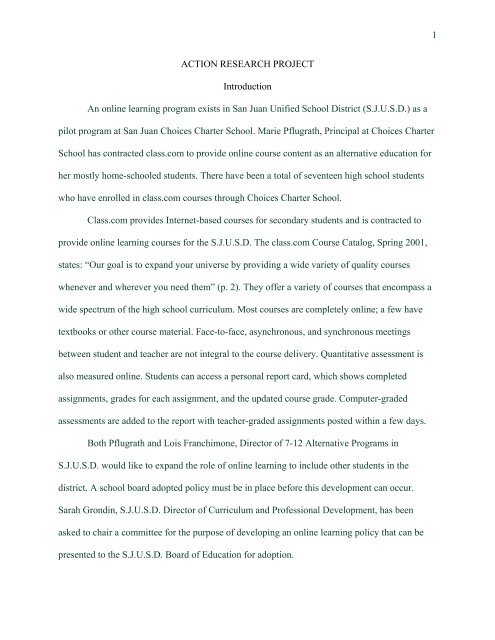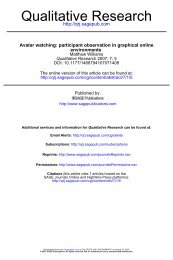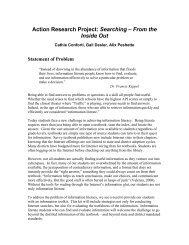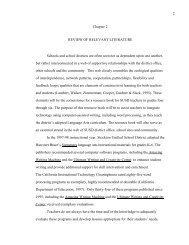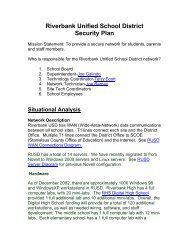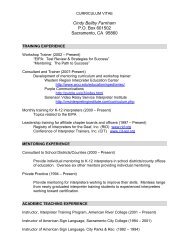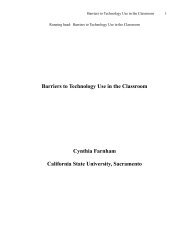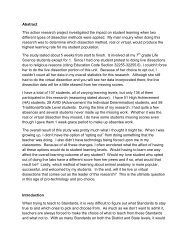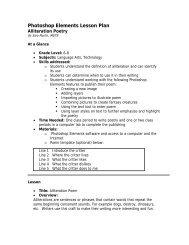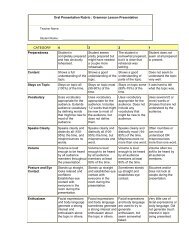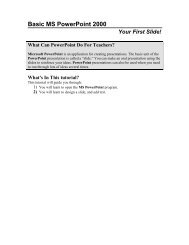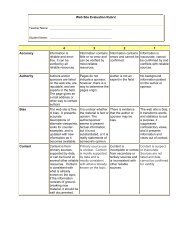Action Research Project: - iMET
Action Research Project: - iMET
Action Research Project: - iMET
Create successful ePaper yourself
Turn your PDF publications into a flip-book with our unique Google optimized e-Paper software.
1ACTION RESEARCH PROJECTIntroductionAn online learning program exists in San Juan Unified School District (S.J.U.S.D.) as apilot program at San Juan Choices Charter School. Marie Pflugrath, Principal at Choices CharterSchool has contracted class.com to provide online course content as an alternative education forher mostly home-schooled students. There have been a total of seventeen high school studentswho have enrolled in class.com courses through Choices Charter School.Class.com provides Internet-based courses for secondary students and is contracted toprovide online learning courses for the S.J.U.S.D. The class.com Course Catalog, Spring 2001,states: “Our goal is to expand your universe by providing a wide variety of quality courseswhenever and wherever you need them” (p. 2). They offer a variety of courses that encompass awide spectrum of the high school curriculum. Most courses are completely online; a few havetextbooks or other course material. Face-to-face, asynchronous, and synchronous meetingsbetween student and teacher are not integral to the course delivery. Quantitative assessment isalso measured online. Students can access a personal report card, which shows completedassignments, grades for each assignment, and the updated course grade. Computer-gradedassessments are added to the report with teacher-graded assignments posted within a few days.Both Pflugrath and Lois Franchimone, Director of 7-12 Alternative Programs inS.J.U.S.D. would like to expand the role of online learning to include other students in thedistrict. A school board adopted policy must be in place before this development can occur.Sarah Grondin, S.J.U.S.D. Director of Curriculum and Professional Development, has beenasked to chair a committee for the purpose of developing an online learning policy that can bepresented to the S.J.U.S.D. Board of Education for adoption.
2In an interview, Pflugrath said students who choose independent studies are highlymotivated, are at grade level or above, and are looking to extend their course offerings. Theyhave strong computer skills and use computers technology at home. “Many of these students areover-achievers – the GATE, the gifted, and the students who have done AP courses” (Personalcommunication, September 24, 2001).Her characterization does not describe the academically challenged student. The studentswho are engaged in online learning at Choices Charter School are already academicallysuccessful. The opportunity for online learning is presented to a small portion of the districtstudent population. What might concern the education board in their consideration of onlinelearning policy is whether online learning will engage only the successful learner. The boardmay be interested in understanding how online learning can benefit the academic achievement ofall students rather than a few.This study will serve to illustrate to the board the potential for academic success thatawaits all students engaged in online learning. There is no time frame for presenting thesefindings to the appropriate administrators. There is only the promise that the opportunity willpresent itself.Area of FocusThis action research project focuses on elements of online learning that are effective inachieving student academic success. Topics discussed are as follows: student academic needs;the challenge and promise of technology; student assessment and accountability; the learningparadigm shift; and the components of quality online learning programs.
3Statement of the ProblemWithin the San Juan Unified School District, there are students who are havingdifficulties achieving academic success in the traditional classroom environment (Personalcommunication, Marie Pflugrath, August 20, 2001). Online learning, a recent development ineducation, offers an alternative learning environment. Although online learning offers manyattractants for engaging the learner, educators ultimately want to know if online learning is goingto lead all of its participants to success. Therefore, it must be determined if online distancelearning will help students achieve academic success.Rationale StatementThere is a call to develop distance education capability in the San Juan Unified SchoolDistrict (Personal communication, Lois Franchimone, August 10, 2001). The district schoolboard must adopt a policy before an online learning program can be implemented. Beforepresenting to policy to the board, it must be determined if the use of online learning programswill be successful in the academic achievement of the student population. Concerning onlineeducation in S.J.U.S.D., there are questions require answers.<strong>Research</strong> QuestionsHow does online education address secondary student academic needs? What are studentacademic needs? What are the causes and conditions of academic need? What are the causes andconditions for academic success? What are the environmental conditions for academic success?What conditions must be present for learning to take place? How does technology function in thecapacity of student learning? What opportunities for learning are made available because oftechnology? Can technology by itself support academic achievement? How does online learning
4function to improve academic achievement? How does online learning address studentaccountability?Definition of TermsOnline learning is the achievement of learning, advancement of knowledge, or creation ofscholarship while connected to a network of computers, a local or wide area network, or intranet,or the Internet. Other communication between the student(s) and the teacher (e.g., coursedocuments, online syllabus, discussion boards, email, online testing, automatic grading,homework drop boxes, slide presentations) can take place without anyone actually seeing oneanother. This definition characterizes the available courseware on the market today (includingclass.com). Online providers have so far evolved through three generations of online coursedevelopment. Initially, students were provided with course handouts, instructional materials, andInternet links with developmental education sites that support the face-to-face instruction. In thesecond generation, online courses provided materials and also required students to interact onlineusing asynchronous e-mail, bulletin boards, and web-based forms for worksheets and tests. Thisdevelopment essentially replaced the need for face-to-face interaction. The third generationadded the benefit of synchronous interactivity through chat rooms, audio/visual conferencing, orMUDs (multi-user dimensional environments) and MOOS (multi-user object oriented systems)(Shedletsky, 2001).Face-to-face refers to the physical meeting between student(s) and teacher. In comparisonto the online learning environment, face-to-face is a characteristic of the traditional schoolenvironment.Asynchronous chat is a derivative of bulletin boards: individual postings on a serveraccessed, with permission, by others. “In asynchronous communication, faculty and students
5send and receive messages whenever they want” (Shedletsky, 2001). Some forms ofasynchronous chat are: discussion groups, email, and the forum, wherein the instructor poses aquestion or a problem for students respond to. The written letter characterizes asynchronous chat.Synchronous chat is real-time online conversation and can involve several peoplesimultaneously. “With synchronous communication, the instructor and students send and receivemessages during the same time period” (Shedletsky, 2001). An example of synchronouscommunication on the Internet is Tappedin (http://www.tappedin.org). Synchronous chat ischaracterized by the telephone conversation.Limitations of the StudyArguments to consider regarding adopting online learning policy include cost, staffdevelopment, technology assessability, and curriculum development. While these importantissues require careful analysis and evaluation, they are not within the scope of this study.Although this study references and analyzes online learning providers (notably,class.com), it was determined not to be within the framework of this study to evaluate theprovider’s product. This study evaluates online education in a general sense and not a specificone.Since this is a study of the online learning environment, comparisons are made to thetraditional school environment. Other categories of student needs (isolation from school by timeand/or distance, curriculum enrichment) are identified but not examined in this study.Online distance learning is applied to all levels of education as well as other professions.This study is focused on the academic development of high school students and not the academicdevelopment of professionals or primary, post-secondary, or adult students.Summary
6The S.J.U.S.D. wants to expand the role of online distance education for its secondarystudents. This study focuses on the efficacy of online learning to meet secondary student’sacademic needs. The following review of the literature is guided by the research questions posedto address those needs. After the research of the literature is the action research consisting ofinterpretation of collected data as well as the S.J.U.S.D. response to the data. Conclusions andrecommendations follow the action research.Review of LiteratureIntroductionOnline education had its beginnings providing distance education by ham radio in theAustralian Outback at the beginning of the twentieth century. Nearly a hundred years passedbefore an explosion of renewed interest sparked research into its effectiveness. Today, onlineeducation programs are available to anyone, anywhere, at anytime. In an online educationjournal, Vail (2001) writes:The Virtual High School and the Florida Online High School in Orlando, Fla., are the twogrande dames of online schools. Both were founded five years ago – ancient history, byonline standards – and both serve as models for other online education ventures”Because it is a recent development in education, online learning does not have anextensive or elaborate research history. During an interview, Mitch Hall, Director, CaliforniaTechnology Assessment <strong>Project</strong> (CTAP), Region 3, said:One reason why there is so little research concerning online learning is that it’s new.When Bill Clinton became president, the Internet was being used for limited purposes.The explosion happened in the 1990’s. That’s hardly a beginning in the world ofeducational research. Ten years ago, these types of questions weren’t being asked. The
7Internet as we know it today hardly existed” (Personal conversation, September 19,2001).This investigation begins with an examination of student needs as they relate to academicachievement. Next, the challenge to students that technology presents is discussed followed bythe promise of technology to address both quantitative and qualitative learning modalities. TheParadigm Shift suggests that a fundamental change in the learning environment has occurredsince the advent of technology in education. Finally, a description of the quality online learningprogram leads to recommendations for its application in the education community.Student NeedsIn this statement, Thornburg (1998) links the education imperative with the roletechnology can play:It is imperative that educational systems constantly strive to insure they are meeting theneeds of their students . . .. Fortunately, vocal parents, educators and students arecontinuing to pressure schools to change in ways that insure that our students areprepared for their future, not for our past”(p. 32).The importance of applying this imperative to an online learning program is critical to itssuccess. Marsha Connely, coordinator for the Instructional Technology Center at AmericanRiver College in Sacramento, California, advises, “Find out what the needs of the students areand build an online program around that” (Personal communication, September 13, 2001).Categories of StudentsThere are three categories of students for whom online classes may apply. The firstcategory of student is disengaged from the traditional school because of time and/or distance.This includes students who are: home schooled; international; isolated because of a medical
8problem; victims of overcrowding; suspended or expelled; employed; on accelerated curriculumschedule (early graduation); remotely located to a school; having difficulty coping with the timeand place of school; overscheduled and need online classes to free up elective coursesA second category of student is looking to enrich the school curriculum. This includesstudents who are: advanced and wish to work at their own pace; seeking classes not available attheir school site; wanting to learn new things; seeking more and/or greater challenges; seekingalternative modes of learning; wanting to take Advanced Placement courses.A third category of online learning candidates is those students who are disenfranchisedfrom learning in the traditional school environment. These are students who: have graduationrequirement deficiencies; need basic instruction to improve skills; have been suspended orexpelled; have failed classes and need to make them up; are dropouts studying for a GED(Bishop, personal communication, October 2, 2001; November, 2001, p. 83).Attendance Factor“Any time, any place, any path, any pace,” the byline of Florida Virtual School(http://www.flvs.net/), seems to have become the mantra for every off-the-shelf online providerin existence. Online course providers seem to be targeting the category of student who isphysically displaced as well as the student desiring curriculum enrichment (Endacott, 2000).Certainly, the “any time, any place” feature of online learning is appealing for the studentexperiencing attendance difficulties. For those students, regular attendance may benefit theiracademic achievement. “Not surprisingly, regular attendance at school helps students todemonstrate those cognitive skills that are directly or indirectly the mission of the school”(Gardner, 1991, p. 137).
9Marie Pflugrath, mirrors the efficiency and expediency that online learning offersstudents. She says that an underlying theme among her students is that they do not want to wastetime – they want to be in charge of their curriculum and material and they want to do it at theirown pace (Personal communication, September 24, 2001). Her students are not particularlymotivated to attend regular school, so they attend online.School EnvironmentThere are many characteristics within the traditional school environment that interferewith academic achievement. Hixson and Tinzmann (1990) identify school factors that hinderacademic achievement. They include: inflexible schedules; narrow curricula; a priority focus onbasic/lower-order; inappropriate, limited, and rigid instructional strategies; inappropriate textsand other instructional materials; over-reliance on standardized tests to make instructional andcurricular decisions; tracking; and isolated pull-out programs.Gardner (1991) refers to some of the school characteristics described by Hixson andTinzmann as institutional restraints that can be unilaterally applied:Schools are institutions that place together individuals who have not known one another,to work on tasks that appear more or less remote from the operation of the remainder ofsociety. It is hardly ideal to have to transmit knowledge in mass form, with tens or scoresof students in the same room, each with separate strengths and weaknesses, approaches tolearning, goals, and aspirations. Teachers must also deal with non-cognitive problemsthat best their students, problems that are seemingly unrelated to the overt mission ofschools yet that can cripple a class as effectively as would a plague or a fire (p. 138).
10Social BehaviorsStudents can become complacent when continuously confronting a school environmentthat seems incapable of functioning on their behalf. Some students respond to this environmentwith what Caine and Caine (1994) call downshifting. “Downshifting is a psychophysiologicalresponse to a perceived threat accompanied by a sense of helplessness and lack of self-efficacy”(p. 69). Other students act out their frustrations with the school environment by misbehaving.Some of the frustrations of learners in the traditional school are a result of themisbehaviors of other students. Indeed, misbehaviors not only require the attention of theteacher, thereby disrupting the learning process for others, they violate other students’ right tolearn. Mitch Hall describes how the online learning alternative circumvents this difficulty. “Theonline experience does not permit public reinforcement of misbehaviors that will often impedethe growth of the individual in the traditional school” (Personal communication, September 19,2001).EmotionsSchool life in a bureaucratic environment can be difficult for young people. Somestudents respond to its conditions emotionally. Bracey (1995) tells us there is a loss of sustainedpersonal contact between the staff and the students. This loss of personal contact coupled withenormous student population creates a feeling of anonymity within the individual. Anonymitybecomes the culprit of low self-esteem. Damasio sees a relationship between the inability toreason and the conditions that appear in a typical high school environment. “I see some failuresof rationality as not just due to a primary calculation weakness, but also due to the influence ofbiological drives such as obedience, conformity, the desire to preserve self-esteem, which areoften manifest as emotions and feelings” (p.191).
11Emotions are integrally involved in our ability to learn. “The fact is, unless we attend tohow students feel about what they’re doing, it’s less likely that they will become excellentlearners” (Kohn, 1999, p. 26). According to Caine and Caine (1994), teachers need to understandthat students’ feelings and emotions determine learning. “Because it is impossible to isolate thecognitive from the affective domain, the emotional climate in the school and classroom must beconstantly monitored on a consistent basis, using effective communication strategies” (p.90).Meaningful LearningGiven such an environment, it is easy to understand why some students becomedisinterested and unmotivated. Is the student not challenged because he or she is not interested inthe subject? The onus of school accountability is now on quantifiable, standardized testing.School is perceived as more focused on subject matter than students. Consider, for example,students who are identified as having low reading ability. It is likely that such students camethrough a phonics reading program that emphasizes decoding and drill exercises – quantifiablemeasures. Students in a Whole Language reading program, on the other hand, read for meaningand understanding within a context – qualitative measures. The presumption that students in aWhole Language reading program are engaged in meaningful learning would be correct (Kohn,1999, p. 161).I witnessed a young student ask his teacher if he could read a certain book from thebookshelf in his classroom. The teacher told him that the book he wanted to read isn’t tested(subject for standardized testing). The student told his teacher that he was really interested inreading that book and that it had four stars on its cover. The teacher told him to go ahead andread the book if he wanted, but reminded him that the book is not tested. The student put thebook back on the shelf and did not read it.
12Intrinsic MotivationThere has been an explosion of discoveries in brain research in the last ten years. Thesenew understandings can be applied to the teacher-student relationship. “The evidence indicatesthat learning is fostered by creativity and challenge. These factors together foster intrinsicmotivation” (Caine, 1994, p. 83). Meeting student academic needs, then, involvesaccommodating the human brain for learning. Brain growth is maximized when the learning ismeaningful, challenging, and accompanied with interactive feedback. Examples of challenginglearning are project-based learning, problem solving, critical thinking (high-order thinkingskills), relevant tasks, and complex activities. Collaborative groups give social and academicfeedback. Video games, computers, and peer editing give specific feedback. <strong>Project</strong>-basedlearning, and game playing provides interactive, multi-modal feedback. The ideal feedbackinvolves choice and is controlled by the learner (Jensen, 1998, p. 33).According to Caine and Caine (1994), the key to academic success is intrinsic motivationand is related to meaningful learning. Their research indicates that the following conditions workto counter downshifting:• Outcomes should be relatively open-ended.• Personal meaning should be maximized.• Emphasis should be on intrinsic motivation.• Tasks should have relatively open-ended time lines.• Tasks should be manageable and supported.(p. 85)
13Jensen (1998) agrees that the search for meaning is paramount to understanding and keyto intrinsic motivation. “Any discussion about intrinsic motivation must also include thelearner’s natural search and subsequent construction for meaning “ (p. 67).Learning EnvironmentJensen (1998) lists factors in the learning environment that function to either increaseintrinsic motivation or increase apathy and resentment. Factors that increase intrinsic motivationare: providing choices; making the task relevant to the student; and engaging the learner. Factorsthat increase apathy and resentment are: making the task required, irrelevant, and passive, that is,disconnected from the real world (p. 48). Intrinsic motivation, then, is dependent on the learningenvironment. The enriched lab rats have bigger cages, more toys, and lots of playmates (Healy,1990, p. 70).Memory RetentionFor academic success to occur, it is critical for students to be able to retain factualinformation. “The way to retrieve this type of learning is through strong activation with rhymes,visualization, mnemonics, peg words, music, and discussion” (Jensen, 1998, p. 109). The mentalstimulations Jensen refers to are within the online experience. They become manifest throughmulti-media (sometimes referred to as hypertext or hypermedia), and a feature unique to thecomputer environment called interactivity.Higgins and Boone (1996a) define multi-media as a blending of new graphic capabilitieswith text-based formats. “Multi-media can describe both the microcomputers themselves and thesoftware that is run on the computers.” Multimedia is simply the use of multiple types of mediato convey a message. Currently, cutting-edge multimedia consists of all the elements of the pastenhanced by extremely high-quality digital visuals and audio in an interactive package that
14invites user involvement. This can be delivered on CD-ROM, DVD, or over the Web. The goalof multimedia in education is to immerse the student in a multiple sensory environment in orderto transfer and infuse knowledge and understanding by mimicking experience as closely aspossible. In this way, multimedia addresses different learning modalities. Auditory learners,visual learners, and tactile learners benefit from varied presentations of information. Studentsoften have the opportunity to select the most meaningful information avenue for themselves. Tohelp students appreciate a literary work in a way that books cannot achieve, one mightincorporate dynamic hyper-linked text with images, literary criticism resources, translations, andrelated Web sites (Gray, 2000).The effect of multi-media enhancement is that it benefits retention of factual information.Higgins and Boone (1996b) found that students increased “retention over time when theinformation was contained in a hypermedia enhancement note as compared to when it wascontained in the main body of text.”With interactivity, the computer engages the user to respond to its prompts. Probably thefirst worldwide awareness of computer interactivity was the computer HAL in the StanleyKubrik film, “2001, A Space Odyssey”. The element of interactivity is commonplace in onlinelearning. Interactivity mostly functions to provide feedback, an important ingredient to academicsuccess. John Bishop describes how interactivity is employed in the class.com learning program:Students are asked in a science class to drag items from a list on the left to a column ofeither element or compound. If they drop the item in the wrong column, it goes back tothe left and the student must try again (Personal communication, October 5, 2001).
15ConclusionMeaningful learning is important to academic achievement. Academic success requires alearning environment that stimulates, challenges students, and promotes intrinsic motivation. Thetraditional school environment could be improved upon in meeting student academic needs.The Challenge of TechnologyThe amount of information inundating students’ lives today seems to have grownexponentially in the two generations because of technology Jensen (1998). “This virtualavalanche of data can cause us to simply shut off as a coping mechanism. In schools, moreclasses, more content, and more information to learn can have a negative effect on students:stress from information overload” (p. 91).On top of this massive amount of information is the learning curve associated with usingthe tools of technology. These tools benefit accessing, selecting, and processing enormousamounts of information. The skills necessary to use these tools are a part of twenty-first centuryexistence. Student capabilities for manipulating data, research, and information gathering andpresenting require skills in database, spreadsheet, presentation, word processing, and using theInternet.Student Prerequisites for Online LearningFrank Odasz (1998), an online instruction designer in Alaska, lists Student Prerequisitesfor Online Learning Outside the Classroom. It is interesting that many off the skills on this listcorrelate with twenty-first century work skills required in today’s work world.• Students must have convenient access to the Internet at home, or through school,library, and community computer labs.• Students must have basic knowledge of using computers and navigating the Internet.
16• Students must have their own email accounts, or access to a group conferencingprogram.• Students must demonstrate the maturity to responsibly use the Internet and their ownemail accounts, or lose these privileges.• Students must be self-motivated to get online and conduct their “homework” Internetactivities.• Students must have the self-confidence and maturity to be engaged in their ownlearning to the degree they will interact openly and honestly.November’s (2001) list of online student’s traits also reflect a twenty-first century workethic:• Motivation;• self-discipline and responsibility;• the ability to work independently(p. 83).George Siemens, online instructor at Red River College in Winnipeg, Manitoba, poses asurvey to potential online learners. Here are some of the self-test questions:• Are you self-motivated when learning new skills?• Are you a self-disciplined person?• Do you set goals for yourself?• Do you procrastinate in completing assignments and studying for tests?• Are you comfortable with chat or instant messenger programs?• Do you tend to participate in classroom discussions?
17• In your regular courses, do you find that you end up cramming in order to completeassignments on time, or to study for exams?• Do you learn from your fellow students sharing their experience?Teamwork and collaboration, self-discipline and self-motivation, and the ability toefficiently and effectively communicate are important traits for success in the Information Age.Marsha Connely described the traits developed with online learning that are relevant toemployment in today’s world: “People who are self-directed, able to conduct online research,can work collaboratively with others, understand time management, and posses goodcommunication skills” (Personal communication, September 17, 2001). These same criteria haveentered the University of California admissions standards. Admissions officers will now lookbeyond simple quantitative measures in forecasting whether a student will be successful. In awritten essay, student candidates must exhibit such intangibles as leadership qualities and selfmotivationto qualify for success (Hardy, November 14, 2001).Student Obstacles to TechnologyNot all students respond successfully to the challenges of technology. “Obstacles tosuccess are mostly attributed to individual motivation”, said Mitch Hall. Students may havedifficulty meeting deadlines, responding to rapid keyboard communications, or processinginformation (Personal communication, September 19, 2001). The mountain of information facingonline students may have a negative affect on the students’ ability to respond (Jensen, 1998, p.91). Challenged to read text from a computer monitor, some students prefer to read text from abook (Personal communication, Marie Pflugrath, September 24, 2001).
18Communication SkillsAn important theme common to the discourse in these three interviews is communicationskills. That may be the greatest challenge for students in the information age. “We need to focusmuch less on teaching students to be computer literate and much more on teaching students to beinformation literate and communications literate” (November, 2001, p. 22). After all, one cannotexpress at a computer without language skills and some keyboard technique. “Today, onlineinstruction is essentially a writing medium resulting in writing intensive courses” (Shedletsky,2001). Knowledge is letters driven, not numbers driven. Keyboarding skills is a prerequisite tosuccessful technology use. Teachers want students to create, develop, and express their ownideas. Healy (1990) recognizes the value that word processing has on developing writing skills:Children who use word processing become more fluent writers and are more willing torevise what they write. Many who have trouble with mechanical aspects of handwritingand spelling find they can express their ideas successfully for the first time. Wordprocessing programs are, without doubt, one of the most commonly used and appreciatedcomputer uses in the classroom (p. 325).Peer ReviewOdasz (1998) attributes success at word processing to peer review: “Writtencommunication requires greater depth of thinking than verbal communication. When writingonline for a peer audience, students are held accountable to articulate what they’ve perceived byvirtue of their online writing leaving a written record.” November (2001) stresses the importanceof a peer audience: “Many students will work harder for an authentic audience (like their peers)than for their own teacher” (p. 69).
19Extensive peer review of online writing adds rigor to the writing experience. Shedletskyand Aitken (2001) point out that posting writings on the Internet can conceivably extend thereadership exponentially:In fact, a very strong argument can be made that a hypertext document will undergo farmore scrutiny in its lifetime than the vast majority of traditionally printed documents everwill. . . . In addition to targeted peer review, it is also much more likely that a hypertextdocument in the WWW will receive consideration from interdisciplinary researchersoutside the domain of knowledge of any particular author.The importance of student writing in evaluation of outcomes cannot be over-emphasized.Qualitative assessment of reflective writing that is peer reviewed is just as valuable asquantitative assessments of student learning. “It is the content of the writings that displaystudents’ understandings and qualitative feedback from students which indicates the value oftheir learning experience” (Graham, 1999).Expectations of Technology“Emerging technologies can fundamentally challenge the current (low) expectations thatexist for many students” (November, 2001, p. 49). Technological interactivity, described earlieras a learning enhancement, also serves to challenge students. Choices Charter School teacherDave Bories presented an example of how technology can raise expectations for students. Davedemonstrated how a spreadsheet on a CD-ROM that accompanies an economics textbookinteracts with the student to create an economic forecast predicated on formulas and calculations.This example also illustrates how interactivity compels the student to respond.Mitch Hall describes almost the same scenario: “Online learning technology can deliverimmediacy to course content that is not available in the classroom. For example, there can be a
20course delivered on CD-ROM that the student interacts with. Computation models can beconstructed quickly with immediate assessment for revision” (Personal communication,September 19, 2001). Notice in this example the immediacy of the feedback. “Feedback isordinarily most useful for learners when it’s immediate” (Jensen, 1998, p. 33).Multi-media, discussed previously, presents another technology challenge for students.John Bishop says, “The traditional learning environment typically does not include multi-mediainput with interaction that is required of the student.”ConclusionLearning the tools of technology and increasing communication skills are synonymouswith employment skills in the twenty-first century. The online learning features of interactivity,feedback, and multi-media not only work to enhance the learning experience, they also work tochallenge the student to respond.The Promise of TechnologySince the Russian satellite Sputnik orbited the earth in 1959, American education hasfocused academic assessment of its high school students primarily on quantitative measures tothe detriment of qualitative measures. Focusing on quantitative outcomes has the effect ofmeasuring sequential thinking processes and devalues simultaneous thinking processes. Withinthe last twenty years, brain research in human learning has indicated that attention tosimultaneous thinking processes have the effect of empowering students to shape and drive theirown learning experiences. It has been shown that technology has advanced qualitative learning,which, ironically, is the direct opposite of our initial response to it.
21Qualitative/Quantitative“A computer is perceived by many people as a scientific instrument for doingquantitative, statistical, objective work, when in fact, a computer is equally a qualitative,interpersonal, and critical tool” (Shedletsky, 2001). This quantitative-qualitative dichotomyaligns with the purposes and usefulness of technology in education. Examples of quantitativeuses of technology are drill and practice, skill sets, programming, database, spreadsheet,simulation, video games, and problem solving. Examples of qualitative uses of technology aremulti-media presentations, Internet research, projects, synchronous and asynchronous chat, wordprocessing, and role-playing.Sequential/SimultaneousThe quantitative/qualitative uses and applications of technology have a parallel in howthe human brain functions to process information. “Normal human brains have at their disposaltwo complementary methods of processing information: sequential and simultaneous (oftencalled parallel)” (Healy, 1990). Examples of sequential processing are logical understanding,syllogism, sequence, cause and effect, linear thinking, practicality, and application.In simultaneous processing, the brain solves problems by making associations at the sametime (Healy, 1990, p. 322). With parallel thinking, “the human brain is always doing many thingsat one time. Thoughts, emotions, imagination, and predispositions operate simultaneously andinteract with the other modes of information processing and with the expansion of general socialand cultural knowledge” (Caine, 1994, p. 88). Examples of simultaneous processing aredivergent thinking, association, vertical thinking, emotions, metaphor, creativity, andspontaneity. Healy (1990) points out that people use both processes together when problem-
22solving. “Human brains continually blend simultaneous and sequential processing, although, aswith ‘learning styles,’ different individuals may tend to favor one form over another” (p. 323).The apparent parallel between technology use and human thinking suggests that thequantitative use of technology aligns with sequential information processing and the qualitativeuse of technology aligns with simultaneous thinking. Since the online learning experience readilyincorporates this learning dichotomy in its content, it is well suited to meet student academicneeds regardless of their diversity.Assessment and evaluation of online participants should be compatible with thiscorrelation, for as Lim (2001) says, “The mode of assessment must be consistent with themethods of delivery.” Skills, drill and practice, multiple choice, and standardized tests areassessed quantitatively making a correlation to sequential thinking. Collaboration and projectbasedexercises that promote higher-order thinking skills are assessed qualitatively making acorrelation to simultaneous thinking.Student EmpowermentApplying technology to the student learning process empowers students to achieve theirown learning. According to Bialo and Sivin (1992), students who are empowered when theirinput is valued and included in the learning task; other students provide feedback; and thelearning tasks require problem-solving and higher-order thinking skills.Text-based information and didactic teaching methods do not have the impact ondifferent learning modalities that interactivity with technology does. The capability oftechnology to present information with multimedia addresses multiple intelligences.Interactivity, along with the multi-media aspect of technology, then, works to develop skillsstudents need to be successful in the adult world (November, 2001, p. 49). According to Ivers
23and Barron (1998), multi-media projects reinforce technology skills empowering them to work inthe adult world. “Multimedia projects encourage students to work in groups, express theirknowledge in multiple ways, solve problems, revise their own work, and construct knowledge”(p. 3).The Paradigm ShiftHigh schools traditionally conform to a bureaucratic structure. These are large facilitieswith enormous populations offering a multitude of departmentalized courses and headed by aprincipal who functions as a CEO (Bracey, 1995). The advent of technology has introducedalternatives to the established education system “that break the traditional mold and challengeour long-held assumptions of what constitutes the educational system” (Williams, 1998, pp. 74,75).Online education aligns with the emerging communitarian organization model describedby Ancess (2000). This model restructures the organization and pedagogy of the traditionalschool to “align with the learning needs of students in context so that students can achieveparticular learning goals.” This model is manifest in the charter school supporting the needs ofstudents being home-schooled and “stands in contrast to the bureaucratic school model in termsof values, organization, and pedagogy” (Ancess, 2000). Online learning is available to studentsremoved from mainstream education by providing a community of learners outside of theestablishment (Odasz, 1998). The technology involved in online learning enriches this neweducational paradigm by providing rich and engaging curricula “and regular opportunities forcollaboration, cooperation, reflection, debate, and self correction” (Ancess, 2000).
24ConclusionThe new educational paradigm demonstrates a shift in the mode of delivery fromcognitive-oriented, where authoritative information is placed before students, to socialconstructivistoriented, where students actively seek knowledge, interpret information, and testhypotheses collaboratively (Lim, 2001).The Quality Online Learning ProgramThe quality online learning program attempts to address student academic needs withinthe context of the new educational paradigm described previously. Several components must bepresent for this success to occur.A Community of LearnersIt is the nature of a learning community to be supportive and collaborative. Mitch Hallrelates the bonding that takes place when the opportunities for support and collaboration exist.“The key element to success is building a community of learners so that they have a connection(Personal communication, September 19, 2001). Marsha Connely is just as adamant that thelearning environment includes those opportunities that recognize the socialization needs of thestudents. “A community of learners is built using chat rooms, forums, and email with theinstructor” (Personal communication, September 13, 2001).The Face- to-Face ComponentThe value and benefit of the face-to-face component is both in building a community oflearners and learning to work collaboratively with others. The relationships developed during theface-to-face encounters enable online collaboration during asynchronous and synchronousmeetings. Thus, the face-to-face experience nurtures a community of learners. The collaborative
25learning during the face-to-face emphasizes cooperative efforts and common inquiry as the basisfor learning (Graham, 1999).Face-to-face meetings can occur in a computer lab and are scheduled occasionally. Thesemeetings can be the most intense learning experiences in terms of qualitative work. Groupprojects, presentations, and socializing during face-to-face meetings work to enhance the onlinelearning experience.Enabling TechnologiesLim (2001) has outlined four essential enabling technologies that comprise most onlinelearning programs available on today’s market. Although these technologies are represented inthe online provider’s learning programs, they do not of themselves constitute a complete andcomprehensive learning environment. It is important to understand that just as they haveaffordances, they also inherently posses limitations.In the first, an “interactive multimedia seamlessly incorporates text, hypertext, graphics,animation, simulation, visualization, video and audio formats” (Lim, 2001). This study hasshown the importance of interactivity to engage and motivate the learner.In the second enabling technology, “task-oriented activities support learner-pacedinstruction by providing students with scaffolding and guidance, plus real-time feedback for theonline quiz” (Lim, 2001). This study has demonstrated the value of feedback on academicachievement. However, it has also revealed that task-oriented activities are in little evidence inavailable online provider’s curriculum.The third enabling technology provides an assessment system, which allows the teacherto track student progress. John Bishop related how mechanisms in the class.com program
26provided assessment of student progress. “Most of the tests are computer scored andautomatically posted in the online grade book” (Personal communication, October 2, 2001).It is important to note that this enabling technology supports quantitative and not qualitativeassessment.Fourth on Lim’s (2001) list is an integrated networking and communication system,which supports asynchronous and synchronous communications between all participants. Thesetechnologies are available with online providers in varying degree.Asynchronous communication online largely consists of email and the forum. The valueof email to the online community is that it is conducive to spontaneous discussion, dialog, anddebate. The forum provides an opportunity for students to share with others their thinking,interpretations, and reactions to the ideas that are being presented. The value of the forum to theonline learning community is that learners can compare their thinking and performance with thatof others in the class or that of experts (Caine, 1994, p. 159). This feature allows the learner moretime to think about his or her contribution than in direct and spontaneous responses (Graham,1999). “The forum is for reflective responses where a student can respond to an assignmentwithout the stress that accompanies the need for an immediate response” (Personalcommunication, Mitch Hall, September 19, 2001). Reflection is for personal processing time thatis beneficial to learning (Jensen, 1998 p. 47).Synchronous online communication consists largely of MUDs and MOOS (see Definitionof Terms) and provides an opportunity for immediate interactive feedback. “Students learn bydiscussing concepts rather than just reading. Students benefit by explaining to their peers theirunderstanding of a particular concept or why their interpretation differed from others in thegroup” (Graham, 1999).
27ConclusionA quality online learning program is comprised of person-to-person interactivity as wellas technologies that both benefit a meaningful learning experience and operate to develop andnurture a community of learners.Collectively, face-to-face, asynchronous and synchronous meetings nurture cooperationduring group activities. “Inclusion of cooperation may have several effects: (1) Makingclassrooms more success-oriented; (2) Counteracting some of the social isolation experienced bychildren; (3) Building language skills by creating structured ways of talking together about whatis learned” (Healy, 1990, p. 283). The social and communicative aspects of these componentslead to success in assignments that require cooperation. Jensen (1998) sums up their value to thelearning experience:Essentially, we are social beings and our brains grow in a social environment. Becausewe often forge meaning through socializing, the whole role of student-to-studentdiscussion is vastly underused. When used properly, cooperative learning is highly braincompatible (p. 93).SummaryReview of the literature has shown that factors in the learning environment dictateacademic success for the secondary student. When students are engaged and challenged, theywill succeed. <strong>Research</strong> has shown that technology presents challenges and nurtures intrinsicmotivation for learning. However, technology will not accomplish this mission on its own.Student academic success is measured in both quantitative and qualitative terms. Distanceeducation by itself is restricted to quantitative measurements of achievement. Becausestudent/teacher interaction is committed to online communication, this represents partial address
28of student needs for academic success. Shifting the education environment to the communitarianmodel suggests that online learning is complete when qualitative measures are involved. In thisenvironment, a community of learners is developed that supports academic achievement bysustaining on-going communications via face-to-face, asynchronous, and synchronouscomponents within the online learning experience.<strong>Action</strong> <strong>Research</strong>Presently, class.com is contracted by Choices Charter School (affiliated with S.J.U.S.D.)to provide online courseware as a pilot program. Administrators in the S.J.U.S.D. are nowlooking to expand the role of online learning for secondary students throughout the district. Theywant to know if online learning is effective in gaining student academic success. The review ofthe literature revealed what comprised academic success, the reasons for academic successand/or failure, and the potential of online learning to accomplish that objective. This actionresearch is an investigation of whether or not online learning programs actually meet theobjective. The course of action in this research has three stages: collect data; present data andreview of the literature to administrators; record administrator’s response to these findings. Datais derived from four primary sources: interviews and personal communications, a studentquestionnaire, class.com student data, a case study.In an interview on September 19, 2001, CTAP Region 3 director Mitch Hall said thatthere were three components necessary for a successful online learning program: “Face-to-faceconnections, constant communication (both asynchronous as well as synchronous), and a body ofcontent that can be delivered online.” Hall goes on to say, “When we try online learning withoutthese components, the failure rate is incredible.” Therefore, a successful online program isdetermined by a low dropout rate.
29Data that supports this conclusion is class.com student information from the VHS StudentData Center database supplied by John Bishop. The report gives assessment of 302 high schoolstudents who took class.com courses between January 2000 and August 2000. Only 45 students(15%) completed 50% or better of the coursework, representing a dropout rate of 85%. Threestudents accomplished 100% of the assignments. This evidence clearly implicates the importanceof the face-to-face component in online learning.Of the three components Hall refers to, the one consistently found among all onlinelearning providers is the body of content. Asynchronous and synchronous communication isevidenced in varying degrees among online providers. Class.com has no provision for thiscommunication while Blackboard.com (which provides the accountability interface forclass.com) provides only asynchronous communication. The face-to-face component is nonexistentwith all online learning providers. The online learning provider does not supply ateacher, even if provisions for a teacher are made in the program.A conspicuous illustration of the importance of face-to-face contact between participantsis the student questionnaire. A student questionnaire designed to elicit responses of attitudes andperceived values about online education was mailed to seventeen users of the class.com programadministered through Choices Charter School. (There is currently only one class.com participant,the remaining were past participants.) Only one questionnaire was returned. A variableaccounting for this failure of return may be that the questionnaire consisted of open-endedquestions requiring a written response. This episode does serve to evidence that a lack of meetingface-to-face can work to disengage participants from a task.
30The returned questionnaire supports the argument for face-to-face and suggests otherareas that may be useful to investigate further. The following is the list of questions and theresponses given on the returned questionnaire:1. Does online instruction help you remain on-task? No, I frequently get off-task.2. Do you get distracted from studying from the computer at home? Yes. I found it muchmore interesting and entertaining to play games3. Has online instruction helped you feel better about yourself? No. I felt separated fromthe regular class.4. Do you feel you are more in control or less in control of your own learning based on youronline experience? Less in control. You feel like you are learning nothing.5. How do you feel your online experience has improved your skills in the following areas:Writing – In my program, no writing was necessary.Computation –Communication – No communication was needed.Reading – It was really easy reading.Problem solving – I learned a little about chemistryThinking skills – It was really easy.6. Is there anything about your online experience you would like to change? It is notpossible to teach a student from a program that he/she controls. Also, it is very easy to cheat.It can be surmised that the student who responded to these questions took a chemistryclass online through class.com. The responses indicate a lack of challenge accompanied with atotal absence of monitoring and accountability. These are the very same issues that concern aS.J.U.S.D. committee formed to investigate online learning. These findings were presented to
31Sarah Grondin, who represents the chair of that committee. Grondin agreed that students wouldnot be challenged without Face-to-face interaction. “Unless students find this so intriguing andchallenging, they’re not going to run with it” (Personal communication, November 16, 2001).Grondin stated that a primary concern of the committee with online learning ismonitoring of student work. From this research, she sees very little evidence that class.com isdoing anything to monitor student productivity let alone address district education guidelines.The class.com data demonstrates to Grondin that the company needs to do more in the area ofstudent accountability. “A good question to ask them would be, how could you say thesestudents are enrolled if they don’t do any of the work” (Personal communication, November 16,2001). When the returned student questionnaire indicated that “a little” chemistry was learned,and yet no writing or communication was involved, it gave Grondin pause to consider whetherthere is monitoring of the learning process.The student accountability issue has arrived with the development of online learning.This finding is unexpected because it was not anticipated at the start of this action research. In atraditional school environment, a student is easily identified as the one taking the test – online,that security is missing because the face-to-face component is not present. There does not appearto be much evidence of accountability safeguards built-in to the available online learningprograms. This awareness has Grondin concerned. “How do we know that the person taking anonline test is actually the person enrolled in the class” (Personal communication, November 8,2001). Currently, the only way to secure accountability for test taking is to administer tests in aproctored environment. The American Federation of Teachers have been critical of onlinelearning for the very reason that there is no face-to-face interaction with a teacher to safeguardstudent accountability (Carnevale, 2001).
32No case studies comparing traditional class with online class at the secondary level werelocated. Grondin, however, offered that a study could be set up through Choices Charter Schoolwherein comparisons could be made between courses. “It would be interesting to have a grouptaking class.com independently compared to students taking class.com courses with addedinstructor interaction on a regular basis” (Personal communication, November 16, 2001). Thisseems a moot point to make, however, since Grondin agreed with those findings which indicatethat academic success online is contingent on the presence of a face-to-face component.ConclusionsVarious sources of data as well as the review of the literature are used to drawconclusions about the efficacy of online learning in the academic success of secondary students.A complete online learning program is comprised of a curriculum enriched through technologyand a learning environment capable of sustaining a community of learners. A complete onlinelearning program provides both quantitative and qualitative learning experiences. An onlineprogram that does not have qualitative learning opportunities (asynchronous and synchronouschat, face-to-face) is not going to address student academic needs as effectively as an onlineprogram that does include those opportunities. Technology alone will not educate, there must belive interaction between the student and the teacher to ensure academic success.The potential of online learning is in the empowerment of the student to take control oftheir learning. Online learning is more than capable of academic growth and achievement; it hasthe capacity of providing enriched and meaningful experiences that develop life-long learners.RecommendationsWhile the face-to-face component has been shown to be critical to the success of theonline learning experience, it is not available with online learning providers. Not all online
33learning providers support synchronous and asynchronous chat, either. Class.com does notsupport this capability, for example, while Blackboard does. These components reflect thequalitative use of technology discussed earlier and their absence is typical of most of the onlinelearning providers product on today’s market. For example, former education secretary WilliamJ. Bennett recently opened a for-profit online education company, K12 Inc. The content andapproach of the K12 program is based upon the Core Knowledge curriculum, developed byUniversity of Virginia English professor E.D. Hirsch Jr. It emphasizes phonics-based readinginstruction at the K-2 levels, a Great Books approach to literature and a general commitment tounderstanding Western culture and history. Mr. Bennett insists: “We can guarantee quality aswell as anybody else . . . by virtue of looking at results” (Trotter, 2001). Mr. Bennett’s productappears to be void of the qualitative components discussed earlier. This implies that the productassesses learning by quantitative measures. A learning experience is not enriched when itsquality is determined solely by measurable outcomes.Perry Robinson, deputy director of higher education at the American Federation ofTeachers, says quantitative assessment exams shifts emphasis away from what he considers themost important element: student interaction with professors in the classroom. The federation hasbeen critical of distance learning in the past, saying it should always include a face-to-facecomponent (Carnevale, 2001).Mellon (1999) found that the face-to-face component addressed the learning styles on theinterpersonal learner and the aural learner. Moreover, many students, who preferred one mode orthe other in general, felt that some topics required personal interaction while others did not.“These students emphasized the importance of being able to choose the learning mode session by
34session. Interestingly enough, even in this course where the content was technology, technologyalone was not the best way for each student to learn” (Mellon, 1999).The inclusion of these components in an online learning program benefits studentacademic achievement. Students using an online asynchronous learning network produce morequantity and higher quality solutions than without the computer networking (Benbunan-Fich,1999). Nontraditional students, working students, students with disabilities, and students who aremore adept at written than oral communication skills may adapt well to the nature of studentinteraction and collaboration online (Graham, 1999). Furthermore, Schulman and Sims (1999)found that some students actually received higher scores when enrolled in online study programs.A comprehensive online learning program must contain the qualitative assessmentvehicles of face-to-face, asynchronous, and synchronous components. These measures functionto assess student cognitive abilities, critical thinking, and communications skills. Of particularimportance is the face-to-face component, for without it, student accountability will not beachieved. “Traditional education”, says Charles M. Cook, the director of the New EnglandAssociation of Schools and Colleges' Commission on Institutions of Higher Education, “willprobably slowly follow the lead of distance education. It's in a better position to assess studentlearning than a traditional establishment. It's truly more student-focused and outcomes-focused”(Carnevale, 2001).There was nothing in the presentation of this study that Grondin questioned or was indisagreement with. Her responses were in agreement with the findings. Academic success inonline learning can only be achieved with face-to-face, asynchronous, and synchronouscomponents added. Grondin felt that more studies needed to be made such as the previouslysuggested comparison of learning groups. Further, An examination of the district’s Regional
35Occupation Program (R.O.P.) may be useful in determining the effectiveness of the face-to-facecomponent. The R.O.P. use technology in its instruction and face-to-face interaction betweenteacher and students is commonplace. Another suggestion Grondin offered is to investigate otheronline learning providers and ask what kind of structures they have and what is their completionrate. The effect this study seems to have on Grondin is that she is now aware that onlineproviders are not doing the job and she understands what questions to ask of them in herinvestigations. This action research has served to reinforce Grondin’s experience concerningonline learning and focus her investigations in considering the future of online learning in theS.J.U.S.D.
36BibliographyAncess, J. (2000). The reciprocal influence of teacher learning, teaching practice, schoolrestructuring, and student learning outcomes. Teachers College Record, 102(3), 30.Benbunan-Fich, R., & Hiltz, S. R. (1999). Impacts of asynchronous learning networks onindividual and group problem solving: A field experiment. Asynchronous LearningNetwork. Retrieved October 16, 2001, from the World Wide Web:http://www.alnresearch.org/JSP/search_database.jspBialo, E., & Sivin, J. (1992). Microcomputers: Effects on social interaction in the learningenvironment. Emergency Librarian, 19(3), 2.Bracey, G. W. (1995). Restructuring for higher achievement. Phi Delta Kappan, 76(10), 3.Bransford, J. D., Brown, A. L., & Cocking, R. R. (1999). How people learn: Brain, mind,experience, and school. National <strong>Research</strong> Council. Retrieved September 15, 2001, fromthe World Wide Web: http://www.nap.edu/catalog/9853.htmlCaine, R., & Caine, G. (1994). Making connections: Teaching and the human brain. Menlo Park:Innovative Learning Publications.Carnevale, D. (2001). Assessment takes center stage in online learning. Chronical of HigherEducation, 47(31), 3.Caverly, D. C., & MacDonald, L. (1999). Techtalk: Designing online developmental educationcourses. Journal of Developmental Education, 23(1), 2.class.com. (2001). Vhs student data center (assessment): class.com.Damasio, A. R. (1994). Descartes' error: Emotion, reason, and the human brain. New York.Endacott, K. (2000). Internet-based courses for secondary students: class.com.Gardner, H. (1991). The unschooled mind. New York: Basic Books.
37Graham, M., Scarborough, H., & Goodwin, C. (1999). Implementing computer mediatedcommunication in an undergraduate course- a practical experience. Journal ofAsynchronous Learning Networks, 3(1).Gray, S. (2000, May). Multimedia across the disciplines. Syllabus Magazine, 13.Hardy, T. (November 14, 2001). Write stuff, right U.S. Campus? Sacramento Bee.Healy, J. M. (1990). Endangered minds. New York: Simon and Schuster.Higgins, K., & Boone, R. (1996a). Creating individualized computer-assisted instruction forstudents with autism using multimedia. Focus on Autism & Other DevelopmentalDisabilities, 11(2), 10.Higgins, K., & Boone, R. (1996b). Hypertext support for remedial students and students withlearning disabilities. Journal of Learning Disabilities, 29(4), 11.Hixson, J., & Tinzmann, M. B. (1990). Who are the "at-risk" students of the 1990s? NorthCentral Regional Education Laboratory. Retrieved October 14, 2001, from the WorldWide Web: http://www.ncrel.org/sdrs/areas/rpl_esys/equity.htmIvers, K. S., & Barron, A. E. (1998). Multimedia projects in education. Englewood: TeacherIdeas Press.Jensen, E. (1998). Teaching with the brain in mind. Alexandria: Association for Supervision andCurriculum Development.Kohn, A. (1999). The schools our children deserve. Boston: Houghton Mifflin Company.Lim, C. P. (2001). A holistic approach towards the use of an integrated online delivery andmanagement system. Journal of Educational Media, 26(1).Mellon, C. (1999). Technology and the great pendulum of education. Journal of <strong>Research</strong> onComputing in Education, 32(1), 8.
38November, A. (2001). Empowering students with technology. Illinois: Skylight ProfessionalDevelopment.Odasz, F. (1998a). Alaskan professional development; lone eagles learn to "teach from anybeach!" [Internet web site]. Retrieved September 29, 2001, from the World Wide Web:http://www.lone-eagles.com/eagle.htmOdasz, F. (1998b). Designing k-12 internet instruction [Internet web site]. Retrieved September29, 2001, from the World Wide Web: http://www.lone-eagles.com/currmain1.htmSchulman, A. H., & Sims, R. L. (1999). Learning in an online format versus an in-class format:An experimental study. Technological Horizons in Education.Shedletsky, L. J., & Aitken, J. E. (2001). The paradoxes of online academic work.Communication Education, 50(3), 11.Siemans, G. (2001). More about learning to e-learn. Online Learning News. Retrieved October16, 2001, from the World Wide Web: http://www.vnulearningThornburg, D. (1998). Brainstorms and lightning bolts: Thinking skills for the twenty-firstcentury. San Carlos: Starsong Publications.Trotter, A. (2001). Bennett's online education venture opens for business. Education Week.Vail, K. (2001). Online learning grows up. electronic school.com. Retrieved October 19, 2001,from the World Wide Web: http://www.electronic-school.com/2001/09/0901f1.htmlWilliams, T. (1998). The technology-fed growth of educational alternatives, Computers ineducation: Dushkin McGraw-Hill.


